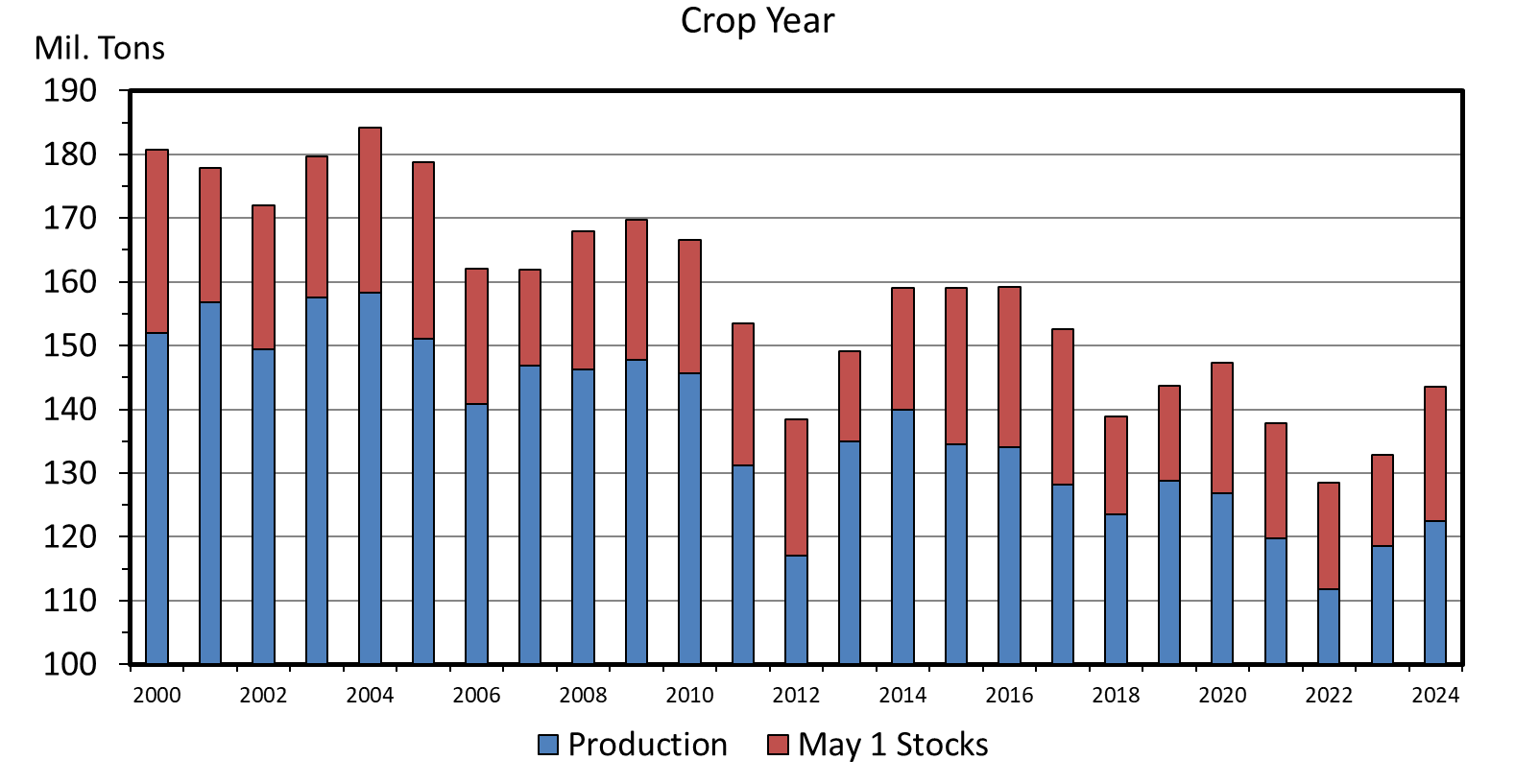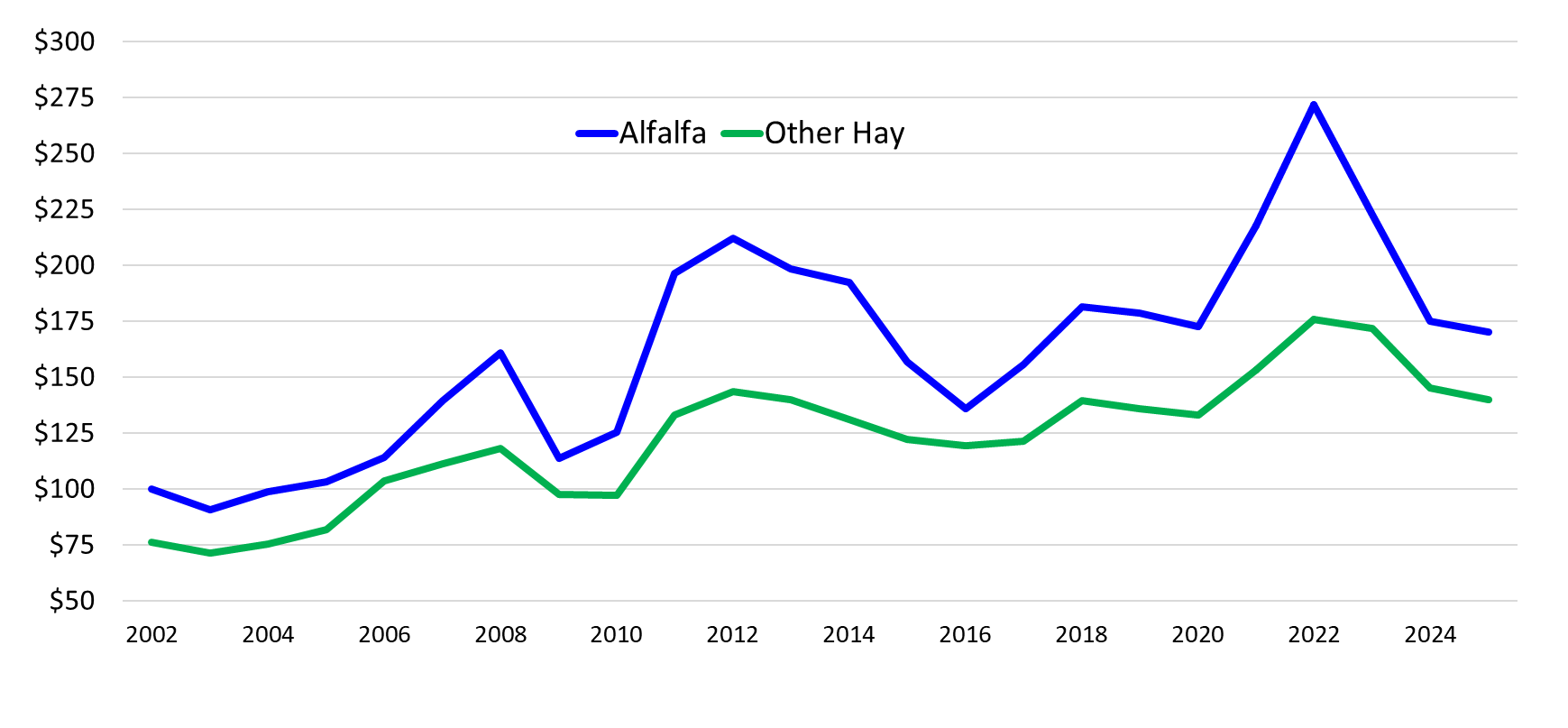Cow-Calf Corner | January 13, 2025
Larger Hay Supply; Lower Hay Prices
Derrell S. Peel, Oklahoma State University Extension Livestock Marketing Specialist
Larger May 1 stocks and increased year over year hay production led to larger hay supplies in 2024 (Figure 1). Total hay production in 2024 was up 3.3 percent year over year and combined with May 1 hay stocks up 46.6 percent over 2023 levels to increase the total hay supply by 7.9 percent compared to year earlier levels. The total hay supply was 1.7 percent below the ten-year average supply from 2014-2023.
Figure 1. U.S. All Hay Supply
Total hay production includes total alfalfa hay production, almost unchanged from 2023 levels and 8.4 percent below the ten-year average as well as total other hay production, up 5.5 percent year over year and 0.6 percent above the 2014-2023 average.
Coming into winter 2024/2025, December 1 hay stocks were up 6.3 percent year over year, though still down 3.2 percent from the ten-year average. Hay supplies have recovered from the drought-reduced levels of 2022-2023 (Figure 1) and, as a result, hay prices have dropped from record levels (Figure 2). Table 1 shows the top ten state rankings for December 1 Stocks; All Hay Production: Alfalfa Hay Production and Other Hay Production and highlights the considerable regional variation in hay production and stocks. Texas is the largest hay producer, mostly other hay, with production and December 1 stocks well above average. Alfalfa hay production was down compared to the ten-year average in some important dairy production states (California and Idaho) as well as in some mostly beef cow states (Montana and South Dakota) that depend on alfalfa hay (Table 1). In many states, increased hay supplies are providing more management flexibility for cattle producers and lower hay costs are reducing annual cost of production somewhat. However, among major beef cow states, Florida, Kansas, Montana, and North Dakota, 2024 December 1 hay stocks are down year over year and below the ten-year average.
| Rank | State | 1,000 Tons | % chg* | State | 1,000 Tons | % chg* | State | 1,000 Tons | % chg* | State | 1,000 Tons | % chg* |
|---|---|---|---|---|---|---|---|---|---|---|---|---|
| December 1 Stocks | All Hay Production | Alfalfa Hay Production | Other Hay Production | |||||||||
| 1 | TX | 7600 | +11.8 | TX | 11960 | +25.5 | ID | 3854 | -11.4 | TX | 11520 | +28.5 |
| 2 | SD | 5600 | +3.3 | MO | 6212 | +0.1 | NE | 3483 | +5.0 | MO | 5460 | -1.8 |
| 3 | MO | 4800 | -10.6 | NE | 6135 | +3.1 | SD | 3480 | -0.3 | OK | 5115 | +4.1 |
| 4 | OK | 4800 | +2.9 | OK | 5895 | +5.6 | MT | 3225 | -10.3 | KY | 4700 | +3.0 |
| 5 | NE | 4300 | +0.3 | SD | 5840 | +5.8 | CA | 3168 | -26.4 | TN | 3586 | -7.2 |
| 6 | MT | 3800 | -5.4 | KY | 5000 | -0.8 | WI | 3030 | +11.0 | NE | 2652 | +0.7 |
| 7 | KY | 3650 | +3.5 | MT | 4815 | -9.2 | IA | 2736 | +2.8 | AR | 2583 | +5.8 |
| 8 | ND | 3550 | -11.3 | CA | 4640 | -19.6 | MN | 2550 | +3.0 | SD | 2360 | +16.3 |
| 9 | KS | 3300 | -28.1 | ID | 4567 | -9.5 | CO | 2498 | -0.4 | KS | 2325 | -28.1 |
| 10 | WI | 2900 | +27.1 | WI | 3904 | +13.5 | UT | 2080 | +0.6 | PA | 2270 | +4.4 |
| Top 10 | 44300 | -1.5 | 58968 | +3.2 | 30104 | -4.4 | 42571 | +5.4 | ||||
| U.S. | 2024 | 81534 | -3.2 | 122462 | -3.3 | 49840 | -8.4 | 72622 | +0.6 | |||
| 10 yr acg. | 2014-2023 | 84237 | 126608 | 54391 | 72217 | |||||||
Figure 2. Hay Price U.S. Avg. $/Ton (2024, 2025 projected)
Retained Placenta in Beef Cattle
Mark Z. Johnson, Oklahoma State University Extension Beef Cattle Breeding Specialist
Retention of fetal membranes, or retained placenta, in cows usually is defined as failure to expel fetal membranes within 24 hours after parturition. Normally the expulsion occurs within eight hours after delivery of the calf. The placenta is retained when the cotyledons on the placenta do not detach from the caruncles on the uterus during parturition. Retained placenta is rare in most cow herds.
Retained placenta creates the potential for problems. It hangs from the vulva which permits manure and micro-organisms from the manure into the uterus. Also, when the cow lays down in dirt or mud which is loaded with bacteria, it permits bacteria to cause infection in the uterus and can have serious negative consequences. Infection in the uterus can cause the cow to become ill (fever, weight loss, etc). In severe cases of infection the cow can actually die. When the uterus becomes infected and inflamed, it takes longer for the cow to clean and be ready for the next breeding season. Retained placentas can result in delayed rebreeding or cows coming up open at the end of breeding season. Bottomline: retained placentas jeopardize reproductive efficiency and can rob operations of profit potential.
What follows is a list of the typical causes of retained placenta.
- Dystocia, as a result of too large a calf, twins or abnormal presentation of the fetus, calving difficulty is a cause.
- Poor nutrition. Inadequate consumption of energy or protein during pregnancy can result in thin cows. Dietary deficiency of Vitamin A, Selenium, Iodine or Vitamin E have been linked to retained placenta. Retained placenta is most often associated with nutrition, in particular, low levels of Vitamin A or the mineral Selenium.
- Stress, obesity and genetics can play a role.
- Infectious diseases like Brucellosis, Leptospirosis, IBR virus or BVD virus.
What are the best management practices to prevent retained placenta? Over time, proper nutrition, herd health and mineral supplementation should solve most the problems. Typically the best source of vitamin A for cattle is green, leafy forage. A good quality free choice mineral supplement containing Selenium is advised. Cows and heifers in Body Condition Scores of 5 to 6 at calving time is advised. If you are dealing with sick cows as a result of retained placenta, consult your veterinarian for best treatment options.
Supplementing Beef Cows during Cold Weather
Paul Beck, Oklahoma State University Cooperative Extension Beef Cattle Nutrition Specialist
Last week we discussed some of the management tips for minimizing the impacts of cold weather on beef cows. The question arises, how much extra supplement is needed to get cows through these weather events?
Let’s consider a 1200-pound pregnant beef cow in the third trimester fed a prairie grass hay that is 90% dry matter (DM), 7% crude protein (CP), and 56% total digestible nutrients (TDN). This cow requires 1.85 pounds of CP and 12.5 pounds of TDN (DM basis) to meet her requirements and would be expected to eat about 24 pounds of hay per day (1.8% of her bodyweight on a DM basis). The 24 pounds of hay plus 2 pounds of 20% range cubes will meet these cows’ requirements for CP and TDN in normal conditions. When daily temperatures drop, TDN requirements increase by 1% for every degree below the lower critical temperature (LCT). For a cow in good condition and a thick winter haircoat the LCT is 32°F. When temperatures get down to 20°F her requirements increase by 12%, from about 12.5 pounds of TDN per day to 14 pounds of TDN per day. As we add more supplement hay intake will decrease, so to meet the shortfall in energy she will require 3 pounds of additional cubes per day for a total of 5 pounds of cubes per day.
For a thin cow with a thin hair coat, it gets to be more critical. She is already needing to gain body condition to increase her chances of rebreeding for the next calf crop so we should already be feeding around 4 pounds of cubes a day. Her LCT is around 40°F. So, when temperatures fall to 20°F her requirements increase by 20% from 13.3 pounds of TDN per day to 16 pounds of TDN per day. To offset this energy deficiency of 2.7 pounds of TDN we need to provide her with 7 additional pounds of cubes per day to keep her from losing additional body condition for a total of 11 pounds of supplement per day. Feeding this much supplement is expensive and hard to manage.
Much of this energy deficiency could be offset if we can provide hay that is higher in quality during the winter storms. But it still shows how important it is to keep our cows in good condition before winter weather sets in. Contact your local Cooperative Extension office for assistance in developing a winter-feeding program for your cowherd.
| Item | TN | Cold | TN | Cold |
|---|---|---|---|---|
| Daily Conditions | ||||
| Good condition Cow (BCS 5) | Thin Cow (BCS 4) | |||
| Critical Temperature | 32°F | 40°F | ||
| Average Daily Temperature | 40°F | 20°F | 40°F | 20°F |
| Hay Intake and Supplement | ||||
| Hay intake, lbs | 23 | 23 | 21 | |
| Cubes fed | 2 | 2 | 4 | |
| Energy Balance | ||||
| TDN Required, lbs | 12.5 | 12.5 | 13.3 | |
| Cold weather adjustment | - | 12% | - | 20% |
| Weather Adjusted TDN Required | - | 14.0 | - | 16.0 |
| TDN provided, lbs | 13.5 | 13.5 | 13.5 | 13.3 |
| Deficiency, lbs TDN/day | +1.0 | -0.5 | 0 | -2.7 |
| BCS change | Gain | Loss | 0 | Loss |
| Additional Cubes needed, lbs/day | - | 3.0 | 7.0 | |


